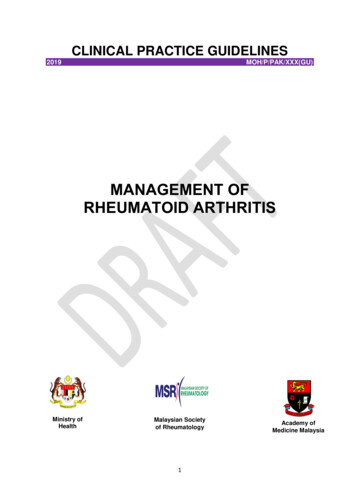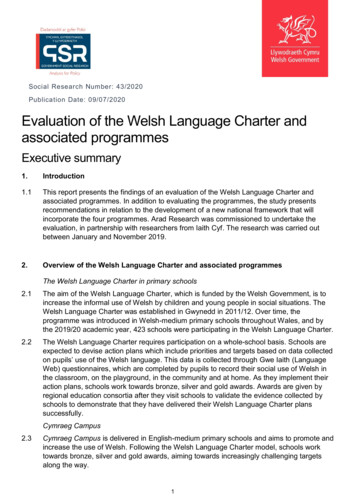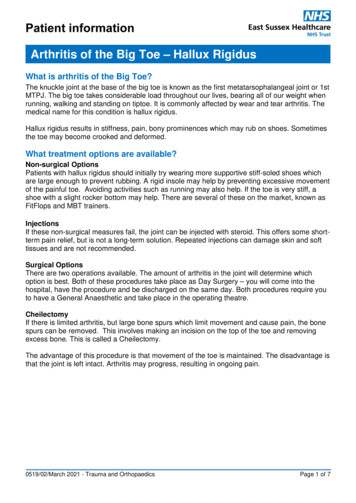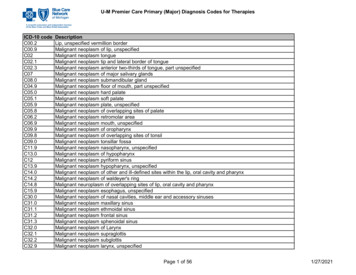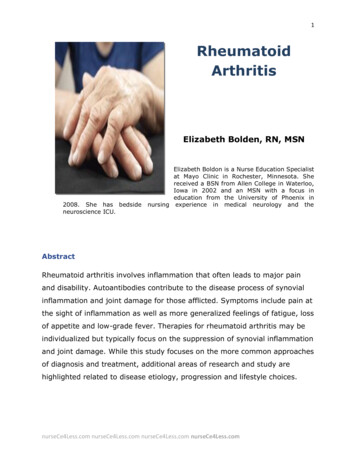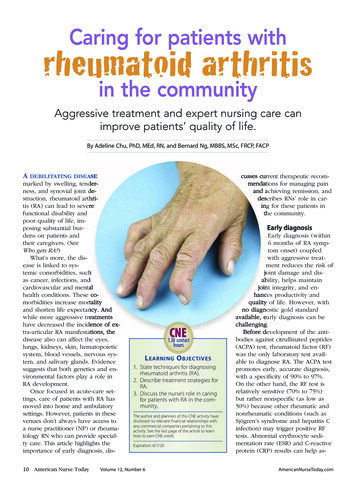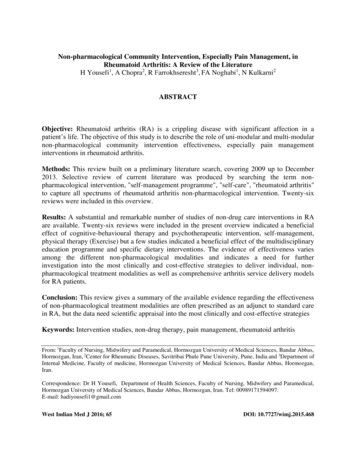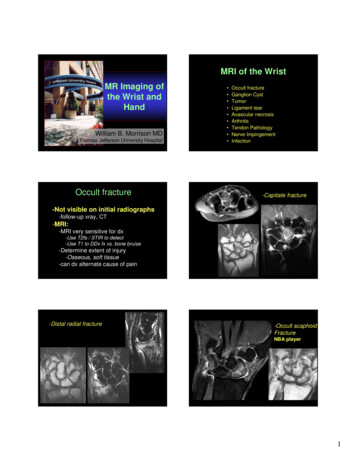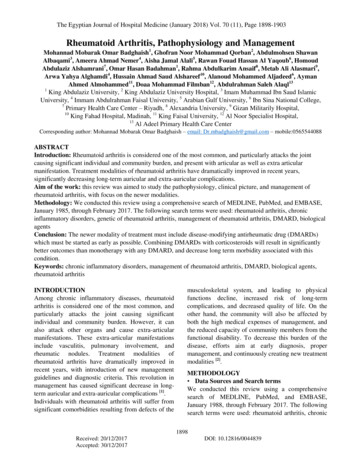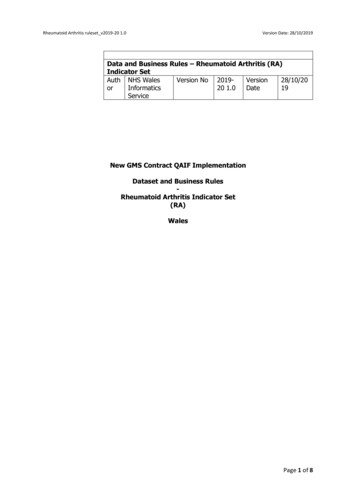
Transcription
Rheumatoid Arthritis ruleset v2019-20 1.0Version Date: 28/10/2019Data and Business Rules – Rheumatoid Arthritis (RA)Indicator SetAuth NHS WalesVersion No 2019Version28/10/20orInformatics20 1.0Date19ServiceNew GMS Contract QAIF ImplementationDataset and Business RulesRheumatoid Arthritis Indicator Set(RA)WalesPage 1 of 8
Rheumatoid Arthritis ruleset v2019-20 1.0Version Date: 28/10/2019Amendment History:VersionDateAmendment History2015-16 1.0W01-July-2015Business Rules 015/16 October Business rules update2016-17 Business Rules update2017-18 Business Rules update2018-19 Business Rules update2019-20 Business Rules update2.0W1.0W1.0W1.0W1.0Page 2 of 8
Rheumatoid Arthritis ruleset v2019-20 1.0Version Date: 28/10/2019New GMS contract QAIF framework implementationDataset and business rules – Rheumatoid Arthritis (RA) indicator setNotes1)The specified dataset and rulesets are to support analysis of extracted data to reflect thestatus at a specified point in time of patient records held by the practice. In the contextof this document that specified time point is designated the “Reference date” andidentified by the abbreviation “REF DAT”. In interpreting the specification REF DATshould be taken to mean midnight of the preceding day (i.e. a REF DAT of 01.10.2020equates to midnight on 30.09.2020).2)To support accurate determination of the population of patients to which the indicatorsshould relate (the denominator population) these rulesets have been compiled with aprior assumption that the reference date is specified prior to extraction of data and isavailable for computation in the data extraction routine. The reference date will also berequired to be included in the data extraction to support processing of rules that aredependent upon it. It is possible that an alternative approach could be adopted in whichrules to determine the denominator population by registration status would be applied asa component of rule processing. If this second approach were to be adopted it would beessential to specify default time criteria for determining the registration characteristics ofthe denominator population during the data extraction process. Additionally there wouldbe a requirement to supplement the dataset and rulesets to support identification of theappropriate denominator population.3)Clinical codes quoted are (where known) from the April 2016 release of Read codesversion 2.The codes are shown within the document as a 5 character value to show thatthe Read Code is for a 5-Byte system.i)Where a “%” wildcard is displayed, the Read Code is filled to 5 characters with fullstops. When implementing a search for the Read Code, only the non full-stop valuesshould be used in the search, For example, a displayed Read Code of c1.% shouldbe implemented as a search for c1%, i.e. should find c1 and any of its children.ii) Where a range of Read codes are displayed, the Read Code is filled to 5 characterswith full-stops. When implementing the search, only the non full-stop values shouldbe used in the search, For example, a displayed Read Code range of G342. – G3z.should find all codes between G342 and G3z (including any children whereapplicable).4)Datasets comprise a specification of two elements:a) Patient selection criteria. These are the criteria used to determine the patientpopulation against whom the indicators are to be applied.i) Registration status. This determines the current patient population at the practice.ii) Diagnostic code status. This determines the current patient population (registersize) for a given clinical condition.Page 3 of 8
Rheumatoid Arthritis ruleset v2019-20 1.0Version Date: 28/10/2019There are three scenarios within the diagnostic code status, these are where There is a single morbidity patient population (disease register) required(e.g. within CHD). Where this occurs, a single set of rules for identifyingthe patient population is provided. There is a single co-morbidity patient population (disease register)required (e.g. within Flu). Where this occurs, a set of rules for eachmorbidity is provided. A patient must only be included in the patientpopulation (register size) once. There are multiple patient populations (disease registers) required (e.g.within Heart Failure). Where this occurs, a single set of rules for eachpatient population is provided.Where this occurs, details of which register population applies to whichindicator(s) are provided. Where the register size applies to an indicator, this isthe base denominator population for that indicator.b) Clinical data extraction criteria. These are the data items to be exported from theclinical system for subsequent processing to calculate points allocations. They areexpressed in the form of a MIQUEST “Report-style” extract of data.The record of each patient that satisfies the appropriate selection criteria for a givenindicator will be interrogated against the clinical data criteria (also appropriate to thatindicator). A report of the data contained in the selected records will be exported in theform of a fixed-format tabular report. Each selected patient will be represented by asingle row in the report, unless the operator “ALL” is used.The “ALL” statement is used within the Qualifying Criteria for the Clinical data extractioncriteria. Typically the selection for a READCODE COD cluster field is based on a date of“LATEST” or “EARLIEST”. The “ALL” statement is used to select all occurrences of any ofthe codes within the READCODE COD cluster. It selects an array of instances, of whichthere may be more than one for each patient.Rows will contain a fixed number of fields each containing a single data item. Thenumber of fields in each row and their data content will be determined by the clinicaldata criteria. Data items that match the clinical data criteria will be exported in therelevant field of the report. Where there is no data to match a specific clinicalcriterion a null field will be exported.5)Rulesets are specified as multiple rules to be processed sequentially. Processing of rulesshould terminate as soon as a “Reject” or “Select” condition is encountered.6)Rules are expressed as logical statements that evaluate as either “true” or “false” Thefollowing operators are required to be supported:a) (greater than)b) (less than)c) (equal to)d) (not equal to)e) ANDf) ORg) NOTPage 4 of 8
Rheumatoid Arthritis ruleset v2019-20 1.07)Version Date: 28/10/2019Where date criteria are specified with intervals of multiples of months or years theseshould be interpreted as calendar months or calendar years.Page 5 of 8
Rheumatoid Arthritis ruleset v2019-20 1.0Version Date: 28/10/2019Dataset Specification1) Patient selection criteriaa) Registration statusCurrent registrationstatusQualifying criteriaCurrently registered forGMSPreviously registered forGMSMost recent registration date (REF DAT)Any sequential pairing of registration date and deregistration date where both of the following conditions aremet:registration date (REF DAT); andderegistration date (REF DAT)Page 6 of 8
Rheumatoid Arthritis ruleset v2019-20 1.0Version Date: 28/10/2019b) Diagnostic code statusCode CriteriaQualifying diagnostic codesTime criteriaRead codes v2IncludedN040.% N041.N042.% (excluding N0420) N047.N04X.N04y0N04y2Nyu11Nyu12Nyu1G Nyu10G5yA., G5y8.Earliest (REF DAT)(Rheumatoid arthritis codes)ExcludedAge 16 years at REF DATPage 7 of 8
Rheumatoid Arthritis ruleset v2019-20 1.0Version Date: 28/10/2019Indicator rulesetsIndicator RA001: The contractor establishes and maintains a register of patients aged 16 orover with rheumatoid arthritis.The terms of this indicator will be satisfied if the practice is able to produce a data extractionaccording to the above criteria.No numerator or denominator determination is required.Page 8 of 8
Rheumatoid Arthritis ruleset_v2019-20 1.0 Version Date: 28/10/2019 Page 8 of 8 Indicator rulesets Indicator RA001: The contractor establishes and maintains a register of patients aged 16 or over with rheumatoid arthritis. The terms of this indicator will be satisfied if the practice is able to produce a data extraction

